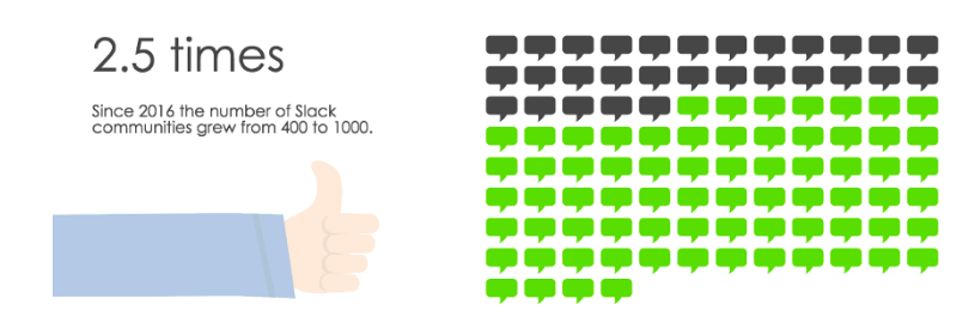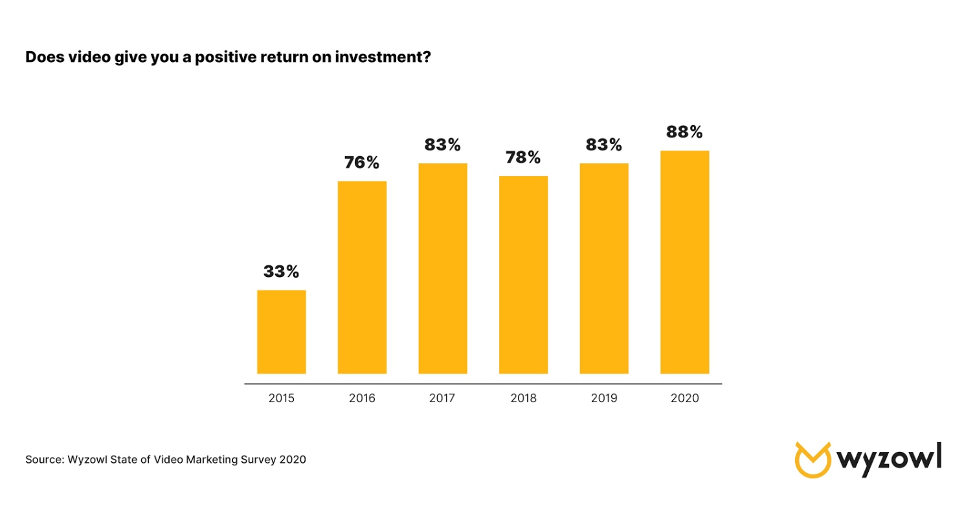It’s that time of year again. Starbucks releases holiday drinks. Crockpots make their way back onto countertops. Last year’s gloves suddenly appear at the bottom of your coat pockets. And content marketers get out their calendars to start brainstorming and prepping for next year.
So we asked a number of industry experts what content marketing trends they’re most excited about—what they want to try, what they expect to see, and why—so that you can use these tactics in your 2021 planning.
Here are the seven biggest content marketing trends you need to know about going into next year:
- Building content communities
- Going live with video and webinars
- Improving content experience
- Focusing on products and services
- Testing AI-powered copy
- Doubling down on SEO
- Repurposing content across channels
Let’s get started!
1. Building content communities
The top content marketing trend to explore in 2021 is no shocker. With the growth of Slack communities in the tech world and the emphasis on personalization in marketing during the pandemic, marketing teams have been focusing on building communities all year. Creating communities centered on content sharing and creation will help marketing teams broaden their reach, even with limited resources.
Lauren Pope, content marketing manager at G2, thinks limited resources and high output demands will help this trend take off next year. “At some point,” she says. “Every content team is going to hit peak content velocity, with every writer creating the max content they can without sacrificing quality.”
She also points to the benefits of expanding your brand’s reach with a community of contributors. “You tap into those writers’ massive audiences on platforms like Twitter, LinkedIn, and just word-of-mouth marketing. This generates more experts who are excited to write for your publication.”
Expanding your reach is great for brand awareness—and, of course, your metrics—but that kind of inclusion is also good for fostering a sense of community with your audience, too. Masooma Memon, a SaaS content marketer, expects this inclusive community feel to have a positive impact on audience engagement. “Whether it’s content for social, your blog, or a webinar, it’s going to continue focusing on making your audience feel like a community,” she says. “Folks love this sense of community belonging. It makes them feel valued, so this trend should continue picking up pace.”
2. Going live with video and webinars
With events out of play this year, video and webinar content has been even more important—and it’s not going away.
“My guess is video marketing including the boom in live video will continue to grow in 2021,” Masooma predicts. But it’s not only because of in-person restrictions; there’s a reason why live video was trending well before the pandemic. “The reason? Video is a quick and effective medium to communicate your message and educate your audience. Consumers want to get information/learn quickly and there’s no better way to do so than with the help of video marketing.”
The fact that most marketers report a positive ROI for video marketing doesn’t hurt, either.
But even more attention on live video and webinars could be a good thing. “Because of this, we’ll probably see some innovative new approaches to webinars,” Patrick Whatman, content marketing lead at Spendesk, said. “Small, exclusive AMA sessions and masterclasses, fireside chats, and more interactive approaches will be more popular. People are less and less interested in sitting through 30+ slides. They want to be able to ask questions and interact. And I’m excited about that element too. I’m involved in webinars all the time, but don’t personally attend many because I feel that the information is available faster (and on my own time) in a blog post. But the chance to be in a small group asking questions of experts is still highly appealing.”
3. Improving content experience
Ever click on an article you want to read only to get to a page filled with pop-ups and ad panels? It’s awful, and most of the time I close out of the page without reading anything. At the same time, I’ll spend clicking around tools like I Miss the Office because they look interesting—even though I definitely don’t miss the sound of coworkers chewing.
The bottom line is that sometimes how you’re interacting with content is just as important as what content you’re interacting with. That’s why a focus on content experience is going to be a key content marketing trend, whether it’s new, interactive content or better UX.
“In order to drive ROI with content, you need to focus on content experience. That means you need users to stay on your website, love what you write about, find exactly what they’re looking for, and enter a sales funnel,” explains content marketing expert Adam Enfroy. “One of my favorite examples of an amazing content experience is Pat Flynn’s learning pages. They include not only text content, but courses, webinars, videos, podcast episodes, and tactical calls-to-action sprinkled throughout. If brands aren’t already creating content silo pages like this to drive leads, they need to start right now.”
4. Focusing on products and services
Another content marketing trend experts are expecting to continue is the tighter focus on bottom-of-funnel content related to core offerings.
Part of this will be motivated by limited resources or conservative marketing plans. “I see businesses trying to stay lean as much as possible over at least the next 6-9 months,” Patrick says. “And that applies to content marketing too. So for starters, I think content marketers will try to stay laser-focused on their key buyer personas and core topics. This isn’t the time to go exploring whole new horizons.”
That laser-focus means more attention to content at the bottom of the funnel, specific to key buyer personas and closely related to the product or service offering. But it can also help with a better understanding of content ROI.
This is already in practice at places like G2, according to Lauren. “Recently, we’ve put much more emphasis on creating content pieces that directly tie into product launches, user-integrations, and much more,” she says. “This makes it much easier to attribute content marketing directly to influenced revenue, plus it supports so much of the amazing work our other internal marketing teams produce.”
5. Testing AI-powered content
When I first tested out an AI-powered content tool this fall, I thought it was cool and futuristic—and potentially a little scary, but more on that in a minute. After I looked into it, I realized that content experts have actually been predicting the rise of AI in content for years.
Now, with tools like the API GPT-3 and Contentyze, which uses AI to take data and create summaries, captions, and even full blog posts, becoming more widely available it’s likely this trends take off in 2021.
“I’ve been on the waitlist for GPT-3 for aaaaages,” Rachel Pilcher, a B2B and SaaS conversion copywriter, says. “This is the thing I’m most excited to try out for my own content marketing. The huge leaps in AI tech lately have some interesting things in store for us as marketers, so I’m really hoping I can get access to this in 2021 (fingers crossed!).”
As for this being a scary trend for content marketers, I don’t think we need to worry. PPC has been debating on automations taking jobs for years—and if anything, automations have allowed account managers to accomplish even more. Plus, I’m sure AI-powered copy will need more content editing than your standard blog posts.
6. Doubling down on SEO
Some trends never go completely out of style but fall in and out of focus. For fashion, it’s corduroys. For beauty, it’s blue eyeliner. For content, it’s SEO.
“I expect to see high quality SEO continue to be a critical piece for content marketing in 2021,” says Sales Hacker Head of Content Brooklin Nash. “Second-movers will continue to figure out how to differentiate themselves from the big SEO titans—capturing niche and long-tail keywords and creating content that’s more engaging than all the ‘Ultimate Guides’ and ‘Top 55’ lists.”
We may have gone too far.
That means spending time creating a solid SEO strategy and digging into keyword research to find those long-tail opportunities is going to be even more important for your content strategy next year.
7. Repurposing content across channels
Now, this might be my favorite content marketing trend. With an emphasis on creating engaging content with fewer resources, it makes sense that next year will bring a bigger focus on repurposing content across channels. When you’re spending time and effort to create high-quality, engaging content, you want to share it with as many people as possible. The best way to do that is to repurpose.
“I’m most excited to see how content teams repurpose content instead of starting from scratch,” Brooklin says. “Brands have figured out the virtual event thing (more or less) in 2020. In 2021, content teams will start figuring out how to most effectively use content from webinars, round tables, podcasts and conferences to stoke the content bonfire. In every panel discussion, there’s at least five social media posts, a blog post, a newsletter mention. We don’t have to reinvent the wheel—just get it turning faster.”
Jump on these emerging content marketing trends now
While you’re planning your content marketing strategy for the year, keep these trends in mind. The overall focus next year is creating high-quality content that does more for your business—without necessarily taking more resources. That’s something we can all use to boost create better content and crush our marketing objectives in 2021.



